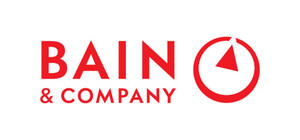HONG KONG, March 15, 2019 /PRNewswire/ -- The Asia Pacific private equity (PE) industry reached new highs last year after a record-breaking 2017 and achieved heavyweight status on the global PE stage. The region now represents 26 percent of the global PE market – up from only 9 percent just a decade ago – with $883 billion in total assets under management. Yet, despite this powerful momentum, uncertainty continues to linger, driven largely by the underlying macro-economic environment, rising interest rates, and the growing polarity between large funds with strong track records, and smaller, less experienced funds. These are the findings from Bain & Company's annual Asia Pacific Private Equity Report, released today.
Propelled by strong momentum, deal value across Asia-Pacific peaked at $165 billion in 2018, above the all-time high of $159 billion of a year earlier and 48 percent greater than the past five-year average. China and India dominated deal-making last year, making up almost 75 percent of total deal value. Exit values also hit an all-time high, reaching a record $142 billion in 2018 –up 39 percent over the past five-year average. However, the total number of exits declined sharply to 402, down 32 percent from the past five-year average. Large exits dominated – exits of $1 billion or more were almost 60 percent of total exit value, and the average exit value doubled to $353 million compared with the average for the previous five years.
Although a core of large and experienced funds raised capital with ease, overall Asia-Pacific focused fund raising was sharply lower in 2018, following a record high in 2017, dropping by more than 50 percent to $75 billion, or 34 percent below the previous five-year average. China's move to enforce more stringent policies on wealth management products to improve transparency and reduce financial risk, together with a record level of dry powder – $317 billion or three years of future investment – after raising ever-larger funds in recent years, significantly curbed fundraising.
"Over the last several years, private equity in Asia Pacific seemed to be unstoppable, and 2018 reinforced that trend in terms of record-breaking deal and exit values. But we're seeing warning signs that suggest the party may be coming to an end, at least for some investors," said Kiki Yang, who leads Bain & Company's Private Equity practice in Asia Pacific. "The increasing market bifurcation and gathering macroeconomic headwinds that we've hinted at in the past are starting to materialize, potentially slowing the revenue growth and multiple expansions that have historically propelled Asia-Pacific PE returns. This means that vulnerable and less differentiated funds could disproportionately bear the brunt of a downturn."
Bain & Company's report identifies three disconcerting market developments that could affect investment activity and returns in 2019. First, US-China trade tensions have increased the risk of macroeconomic disruption in China and across the region. At the same time, deal prices have remained high but interest rates are rising steadily after a period of decline, a trend that will increase the cost of funding and could put a brake on future multiple expansion.
Third, and perhaps most worrying, the region's private equity market has become sharply polarized between large funds with strong track records that dominate activity across the region, and smaller, less experienced funds that are having difficulty raising funds and exiting. According to Bain & Company data, the number of exits of companies sold for less than $100 million plunged to 205, in 2018, down 58 percent from 493 in 2017. By contrast, the number of exits larger than $500 million rose 26 percent to 59.
"The impressive headline figures for the Asia-Pacific PE market in 2018 mask the emergence of a winner-take-all dynamic," said Yang. "With the risk of global recession and other macro-economic challenges, we expect the market for exits will only get tougher."
As the macroeconomic climate becomes increasingly challenging and competition for deals grows more intense, the gulf between winners and losers could widen. Recent experience highlights the risk: Out of the about 500 Asia-Pacific private equity and venture capital funds (excluding real estate, infrastructure or natural resources) that were active in 2007, only 290, or about 60 percent, raised another fund in the wake of the global financial crisis. Roughly half of the multi-asset class investors, had to withdraw from at least one of their asset class.
Big or small, funds are seeking new ways to win amid the risk of a slowdown and in an increasingly selective market. Bain & Company has identified three important themes that will shape the Asia-Pacific private equity market in the coming years.
China tech and Internet. Many General Partners (GPs) have sharpened their focus on China's burgeoning new economy sector to help maintain strong returns in a highly dynamic market. The Internet and technology sectors have accounted for almost 85 percent of the growth in Greater China private equity since 2010. Alluring as that opportunity is, however, PE funds need to understand just how different the rules of the game are in China, the number of failures that litter the landscape, and the risk of betting on a speculative investment bubble that could burst.
Advanced analytics. One powerful strategy is the use of advanced analytics to gain sharper insights during due diligence and better assess the market opportunities and threats to portfolio companies in the new economy and traditional sectors. Some PE funds in Asia-Pacific already have internal or external partners helping them deploy advanced analytics tools to increase their competitive edge, and the trend is now accelerating.
Environment, Social and Governance investing. To respond to increasing public concern, comply with new demands from LPs and reduce their risks, a growing number of global GPs are investing with an eye to environmental, social and governance (ESG) issues and committing a larger share of capital to impact investing. Until recently, most investors assumed that investing for social and environmental impact compromised returns. But a decade of experience has disproven that myth. As a result, ESG investing is gaining traction, allowing PE funds to further differentiate themselves from competitors and create value beyond financial returns.
"Even though we see some potential dark clouds on the horizon, PE investors have proven to be highly capable of outperforming other asset classes in prior downturns," said Usman Akhtar, a partner in Bain's Asia Pacific Private Equity practice. "However, the industry owes much of that to higher performing funds that raise the overall performance of the asset class. In the event of a downturn, we should expect to see a gap between these high performers and the rest of the pack, but those that employ some of the afore-mentioned themes could increase their chances of gaining an edge."
Asia Pacific Private Equity: Country Breakdown
China boasts a large pool of players on the ground, but the country is riding a new economy 'bubble' that could burst at any moment, and the impact of a trade war with the U.S. could have a negative impact on investments. Still, deal value was up 64 percent over the five-year average to $94 billion. Deal count also climbed to 614 – up 32 percent over that same time period. Exit values shot up to $78 billion, while exit count decreased 42 percent over the five-year average to 157.
India's macro outlook is positive overall, though there are concerns over intense competition and sellers' expectations when it comes to rising prices. Deal value increased 79 percent versus the five-year average to $28 billion and exit value jumped 164 percent to $29 billion over that same timeframe. Deal count and exit count dropped, 16 percent and 25 percent, respectively.
Interest in Southeast Asia is increasing from both general partners and limited partners, despite a GDP slowdown. Vietnam and Indonesia, particularly, struggle with high price expectations and the region struggles to influence portfolio companies. Overall, the region experienced a slight bump in deal value – up 38 percent over the five-year average to $13 billion whilst deal count increased to 76 (up 18 percent versus the five-year average). Exit value dropped 48 percent versus the five-year average to $5 billion, as did exit count, dipping 52 percent to 16.
Over the last year, Japan experienced greater activity from new entrants into the market. The trend was towards a smaller pool of large transactions. Near-term deal flow, including secondaries, is solid. However, the country's PE industry struggles to recruit and retain talent. Although deal count in Japan grew 9 percent the five-year average to 53, deal value was down 64 percent over the same period to $4 billion. Meanwhile, $7 billion in exit value marked a 42 percent drop versus the five-year average and exit count plummeted 35 percent from the five-year average to 45.
South Korea experienced solid deal flow, but increased competition and the quest for strong management teams hampered results. Deal value was up 20 percent from the five-year average to $13 billion; deal count was also up 31 percent versus the five-year average to 104 deals. Exit value totaled $14 billion, an 81 percent jump over the five-year average. Exit count also increased, up 18 percent over the five-year average to 77 exits.
Australia is flush with capital and expertise, though still battles against increasing competition against corporates and concerns over valuations going down. Deal value increased 68 percent from the five-year average to $14 billion. Deal count were up to 53 – a 10 percent increase from the five-year average. Exit value and count were also down. Exit values totaled $9 billion, down 19 percent versus the five-year average and exit counts declined 36 percent from the five-year average to 30.
Editor's note: To receive a copy of the report or arrange an interview with Ms. Yang or Mr. Akhtar, contact: Nick Worley at [email protected] or +852 -2978-8830.
About Bain & Company's Private Equity Business
Bain & Company is the leading consulting partner to the private equity (PE) industry and its stakeholders. Private equity consulting at Bain & Company has grown thirteen-fold over the past 15 years and now represents about one-quarter of the firm's global business. Bain & Company maintains a global network of more than 1,000 experienced professionals serving PE clients. The firm's practice is more than triple the size of the next-largest consulting firm serving PE firms.
Bain & Company's work with PE firms spans fund types – buyout, infrastructure, real estate and debt, as well as hedge funds – and many of the most prominent institutional investors, such as sovereign wealth funds, pension funds, endowments and family investment offices. Bain & Company supports its clients across a broad range of objectives that include deal generation, due diligence, immediate post-acquisition, ongoing value addition, exit, firm strategy and operations, and institutional investor strategy.
About Bain & Company
Bain & Company is the management consulting firm that the world's business leaders come to when they want results. Bain advises clients on private equity, mergers and acquisitions, operations excellence, consumer products and retail, marketing, digital transformation and strategy, technology, and advanced analytics, developing practical insights that clients act on and transferring skills that make change stick. The firm aligns its incentives with clients by linking its fees to their results. Bain clients have outperformed the stock market 4 to 1. Founded in 1973, Bain has 57 offices in 36 countries, and its deep expertise and client roster cross every industry and economic sector. For more information visit: www.bain.com. Follow us on Twitter @BainAlerts.
Media Contact:
Nick Worley
Bain & Company
Tel: +852 -2978-8830
[email protected]
SOURCE Bain & Company
Related Links
WANT YOUR COMPANY'S NEWS FEATURED ON PRNEWSWIRE.COM?
Newsrooms &
Influencers
Digital Media
Outlets
Journalists
Opted In




Share this article